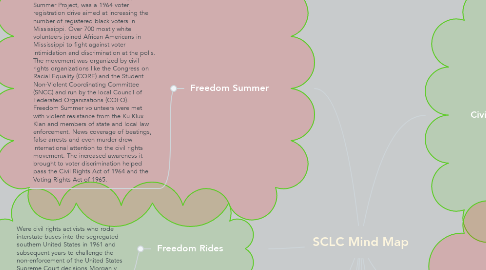SCLC Mind Map
by Marcell Sanchez

1. Freedom Summer
1.1. Freedom Summer, or the Mississippi Summer Project, was a 1964 voter registration drive aimed at increasing the number of registered black voters in Mississippi. Over 700 mostly white volunteers joined African Americans in Mississippi to fight against voter intimidation and discrimination at the polls. The movement was organized by civil rights organizations like the Congress on Racial Equality (CORE) and the Student Non-Violent Coordinating Committee (SNCC) and run by the local Council of Federated Organizations (COFO). Freedom Summer volunteers were met with violent resistance from the Ku Klux Klan and members of state and local law enforcement. News coverage of beatings, false arrests and even murder drew international attention to the civil rights movement. The increased awareness it brought to voter discrimination helped pass the Civil Rights Act of 1964 and the Voting Rights Act of 1965.
2. Freedom Rides
2.1. Were civil rights activists who rode interstate buses into the segregated southern United States in 1961 and subsequent years to challenge the non-enforcement of the United States Supreme Court decisions Morgan v.
3. SNCC
3.1. The SNCC, or Student Non-Violent Coordinating Committee, was a civil-rights group formed to give younger blacks more of a voice in the civil rights movement. The SNCC soon became one of the movement's more radical branches.
4. March on Washington
4.1. The March on Washington was a massive protest march that occurred in August 1963, when some 250,000 people gathered in front of the Lincoln Memorial in Washington, D.C. Also known as the March on Washington for Jobs and Freedom, the event aimed to draw attention to continuing challenges and inequalities faced by African Americans a century after emancipation. It was also the occasion of Martin Luther King, Jr.’s now-iconic “I Have A Dream” speech.
5. Birmingham Campaign
5.1. The Birmingham campaign, or Birmingham movement, was a movement organized in early 1963 by the Southern Christian Leadership Conference (SCLC) to bring attention to the integration efforts of African Americans in Birmingham, Alabama.
6. Civil Rights Act of 1957
6.1. On September 9, 1957, President Dwight D. Eisenhower signed into law the Civil Rights Act of 1957. Originally proposed by Attorney General Herbert Brownell, the Act marked the first occasion since Reconstruction that the federal government undertook significant legislative action to protect civil rights. Although influential southern congressman whittled down the bill's initial scope, it still included a number of important provisions for the protection of voting rights. It established the Civil Rights Division in the Justice Department, and empowered federal officials to prosecute individuals that conspired to deny or abridge another citizen's right to vote. Moreover, it also created a six-member U.S. Civil Rights Commission charged with investigating allegations of voter infringement. But, perhaps most importantly, the Civil Rights Act of 1957 signaled a growing federal commitment to the cause of civil rights.
7. Civil Rights Act of 1964
7.1. The Civil Rights Act of 1964, which ended segregation in public places and banned employment discrimination on the basis of race, color, religion, sex or national origin, is considered one of the crowning legislative achievements of the civil rights movement. First proposed by President John F. Kennedy, it survived strong opposition from southern members of Congress and was then signed into law by Kennedy’s successor, Lyndon B. Johnson. In subsequent years, Congress expanded the act and passed additional civil rights legislation such as the Voting Rights Act of 1965.
8. Montgomery Bus Boycott
8.1. The Montgomery Bus Boycott was a civil rights protest during which African Americans refused to ride city buses in Montgomery, Alabama, to protest segregated seating. The boycott took place from December 5, 1955, to December 20, 1956, and is regarded as the first large-scale U.S. demonstration against segregation.
9. Albany Movement
9.1. The Albany Movement was a desegregation and voters' rights coalition formed in Albany, Georgia, in November 1961. Local black leaders and ministers, as well as members of the Student Nonviolent Coordinating Committee (SNCC), and the National Association for the Advancement of Colored People (NAACP) founded the group.
10. Ku Klux Klan
10.1. Founded in 1865, the Ku Klux Klan (KKK) extended into almost every southern state by 1870 and became a vehicle for white southern resistance to the Republican Party’s Reconstruction-era policies aimed at establishing political and economic equality for blacks. Its members waged an underground campaign of intimidation and violence directed at white and black Republican leaders. Though Congress passed legislation designed to curb Klan terrorism, the organization saw its primary goal–the reestablishment of white supremacy–fulfilled through Democratic victories in state legislatures across the South in the 1870s. After a period of decline, white Protestant nativist groups revived the Klan in the early 20th century, burning crosses and staging rallies, parades and marches denouncing immigrants, Catholics, Jews, blacks and organized labor. The civil rights movement of the 1960s also saw a surge of Ku Klux Klan activity, including bombings of black schools and churches and violence against black and white activists in the South.


